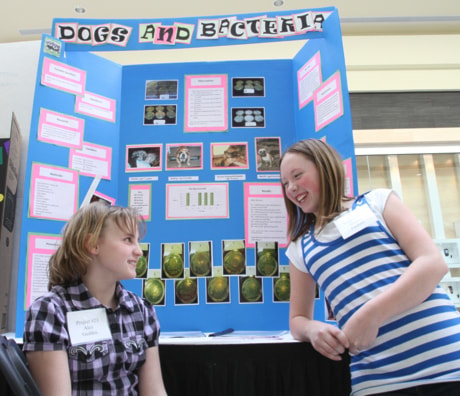Stettler Elementary students Alex Geddes and Hunter Paulson wanted to answer the age-old question of how clean a dog’s mouth really is.
“We wanted to see which type of dog saliva kills bacteria the best. So we tested four kinds of dogs,” said Alex, age 10.
Their test subjects were a shorkie, a bulldog, a mastiff and a German shepherd/Rottweiler cross by the name of Cowboy.
They used petri dishes and a gelatinous substance known as agar — a type of algae used in Japanese desserts and for growing bacterial cultures. The girls cut up filter paper and swabbed the dog’s saliva glands — something Itchy the bulldog wasn’t too keen on. Then the filter paper was added to the agar.
Hunter said all of the dog saliva killed off bacteria well, but they found the mastiff’s saliva to be the most potent.
The youngsters showed off their project on Saturday at the 27th annual Central Alberta Regional Science Fair, which drew 47 projects of students from elementary to secondary school from around Central Alberta. The girls came in with a bronze standing in the elementary category.
Ruth Roedler, the president of the Central Alberta Regional Science Fair, said she has seen students come to the event the first year shy and nervous to talk and the next year full of confidence.
“It’s good for them to gain self confidence. It’s good for them to use the scientific method, which can be used in any area of life. It’s good for them to see there are other people who do the same sorts of things they do and some are enjoying the weekend in the mall,” Roedler said.
Olds High School Grade 10 student Tim Carlielle-Shaw showed off the designs he’d made of various remote controlled planes, trying to take advantage of the ground effect.
When a plane is flying close to the ground the air around the wings flows differently and creates a cushion of air underneath the wings.
It increases lift and decreases drag, making the aircraft more efficient.
Shaw tried a variety of designs, including one based on a past Russian plane, but his designs this year crashed more than soared.
“I was able to conclude from all of those models that building a remote controlled ground effect vehicle isn’t practical just because the wing to vortex ratio isn’t great enough to have a defined ground effect,” Carlielle-Shaw said.
For his efforts, he received a gold standing in the secondary category and will be able to take part in the Canada Wide Science Fair set for May 15 to 23 in Peterborough, Ontario.
He will be joined at the national event by Olds Grade 10 student Collin Fair, who also won secondary gold standing and secondary best of fair, Cremona Grade 7 student Joseph Gelowitz, Innisfail Junior/Senior High School Grade 9 student Austin Morris and Olds Grade 10 students Anika Reynar and Anita Kan.
Elementary gold standing and elementary best of fair went to Deer Meadow Grade 6 student Claire Bertens.
Other prizes were awarded for secondary and elementary silver, bronze and honorary mention, as well as special awards sponsored by businesses, associations and individuals.
sobrien@www.reddeeradvocate.com
